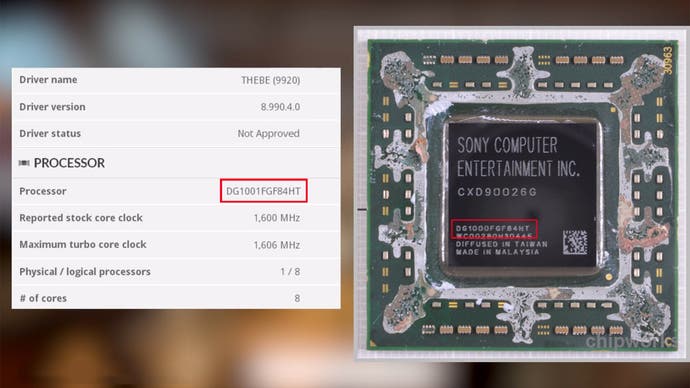In Theory: is PS5 powered by an AMD Gonzalo processor?
Specs have leaked for a new AMD console chip - but what is it?
The first reveal - of sorts - for PlayStation 5 has been and gone, with Sony confirming specs including an octo-core Zen 2 CPU, custom Navi graphics, hardware-accelerated 3D audio, solid state storage and PS4 backwards compatibility. Specifics such as CPU/GPU frequencies and memory allocation remain unknown, but some unlikely - if not downright unbelievable - detective work may have helped to fill in the blanks. This is a story I've been following with interest for three months now with varying degrees of scepticism, but the evidence is starting to look compelling. Bizarrely, it seems that a next-generation gaming processor is being tested on PC benchmarking tool 3DMark - and there's a reasonable possibility that it's PlayStation 5 silicon.
We've seen some unbelievable stories play out in the past, be it the PlayStation 3 Slim making a baffling debut in a Phillipines marketplace, two months ahead of launch. Then there was our first look at the PS4 Slim, materialising in Manchester UK, after early Middle-Eastern units somehow appeared on classified ads site, Gumtree. But next-gen processors listed on 3DMark's results database? That's something else.
The story begins in January, with a Twitter post from Thailand-based technology spy, TUM_Apisak. Apisak has a proven track record in unearthing new hardware by scanning through the online databases of benchmarks from titles like Final Fantasy 15, Ashes of the Singularity - and of course, 3DMark. In the case of the new AMD-designed processor he uncovered, the data reveals two crucial pieces of information - a codename and a product code. Prior leaks also gave scores for each of the tests, but it looks like 3DMark has started to hide these results on the latest entries.
In the case of the new SoC, it's called Gonzalo and deciphering the product code unearths a range of potential specs. Adding further spice to the story is that since January, a second Gonzalo processor has appeared on the 3DMark database - a revised version of the same silicon - giving us further information and some hints on how the chip has evolved in the last three months. However, even when the existence of the first silicon revision came to light, speculation linked it to Sony and PlayStation 5. From my perspective, verifying this as genuine is a lot easier if we can find any kind of prior link between 3DMark database entries and final console silicon.
On the face of it, the whole notion of a Sony/AMD semi-custom design appearing on 3DMark in any way at all seems highly unlikely. The pre-production processors are put through their paces on a Windows system, for starters, meaning that the chip would need to be compatible with Microsoft's OS, and it would require drivers to allow 3DMark to run in the first place - surely a waste of time. And fundamentally, what would running this PC benchmarking tool actually demonstrate - surely AMD would have its own testing suite? Regardless, this bizarre method of finding new AMD designs does seem to check out.
The 3DMark database search methodology is corroborated with two highly convincing examples and a further brace of likely candidates. For starters, there's the Subor Z Plus console from China, which pairs a quad-core Ryzen CCX with a 24-compute unit Vega graphics core. Apisak unearthed the prototype design - codenamed Fenghuang (translation: Phoenix) - some eight months before the console made its debut. However, while a console OS is planned, the Subor hardware launched as a Windows machine, so running 3DMark on it for testing purposes isn't exactly surprising.
The next example is the closest we'll see to ironclad evidence that the 3DMark database does host preliminary tests for Sony console hardware. A processor with a 1.6GHz clock speed appears to have gone through the 3DMark test with the product code DG1001FGF84HT some years ago. Take a close look at the shot below and you'll see that a DG1000FGF84HT code appears on the processor of a final, retail PlayStation 4. It's just one digit out and it seems that minor variations on this code apply across a range of PS4s. If not a smoking gun, we're looking at an astonishing coincidence here.

Apisak himself also points out two further APU designs that seem to indicate testing on two versions of a processor likely to be the Neo chip found in PlayStation 4 Pro, though photos of the actual chip are thin on the ground - and I couldn't find product code matches. These chips are likely to be Pro hardware as I'm not aware of any retail product out there that matches this configuration: a 1.6GHz base clock for OG PS4 compatibility and a 2.1GHz max clock for titles running under Neo mode.
At this point, the evidence is mounting that Apisak's peek into the future of custom silicon design is on the level - despite the unorthodox methodology involved. We can definitively trace two examples of pre-production silicon that end up in console-like boxes - one of them being the PlayStation 4, no less. Weighing up the evidence, it seems likely that the new AMD Gonzalo silicon is real, so what does its product code tell us and how do we know it's destined for a games machine as opposed to a desktop processor?
Back in January, Apisak revealed the Gonzalo codename and backed the product code with an image designed to help decode it (I've expanded on it below). It's based on examination of existing AMD chips and as Gonzalo has elements that don't match any existing chip, some aspects of the code such as cache configuration can't be ascertained. But what it tells us is that it's an engineering sample for a product designed for a games machine (the second digit - G - would be a D for a desktop APU) featuring eight CPU cores with a 1.6GHz base clock and a 3.2GHz boost clock. At the end of the code is a PCI identifier for the GPU, previously identified on the Chiphell forum as Navi Lite - which by extension, all but confirms that it's a 7nm design. A disappointment seems to be a GPU base/boost clock speed locked to just 1.0GHz.
Gonzalo's April 2019 revision sees the chip move from engineering sample to qualification sample status - effectively, a final 'beta' for the processor's design, moving from an A2 stepping to a B2 stepping in the process. Everything else seems much the same with one massive exception: GPU clocks increase enormously. The base clock remains at 1GHz, but the max frequency is now a remarkable 1.8GHz. It sounds too good to be true, to be honest. It's almost a 2x increase in frequency over PS4 Pro's GPU, and a 54 per cent boost over Xbox One X's clocks.

| 36 CUs | 40 CUs | 44 CUs | 56 CUs | 60 CUs | 64 CUs | |
|---|---|---|---|---|---|---|
| Shaders | 2304 | 2560 | 2816 | 3584 | 3840 | 4096 |
| GPU Clock (MHz) | 1800 | 1800 | 1800 | 1800 | 1800 | 1800 |
| Compute (TFLOPS) | 8.3 | 9.2 | 10.1 | 12.9 | 13.8 | 14.7 |
However, it is a match for the peak GPU boost clock of Radeon 7, which has a very console-like silicon area of 331mm2. But looking at AMD's $700 GPU, that monster requires some serious cooling - something which isn't impossible but certainly a challenge for a console-sized form-factor. Assuming that the clocks are accurate, the table above demonstrates how the teraflops work out for various compute unit configurations, starting with the 36 used in PS4 Pro and ending up with the maximum 64 in current GCN designs. This does assume that a new AMD compute unit still has 64 shaders, which isn't a given - remember that we still know very, very little about the Navi architecture confirmed to reside within PlayStation 5.
However, maybe raw graphics performance isn't the key focus for the next wave of console hardware. It's interesting to note that both Phil Spencer (in last year's Giant Bomb E3 interview) and Mark Cerny in this week's Wired piece have veered the conversation away from teraflops and GPU compute in general. Spencer has focused on the CPU - where Ryzen architecture should deliver a huge increase in power - while Cerny's emphasis on graphics in the next-gen Sony console seemed to be focused more on ray tracing.
Combine this with the leak that Microsoft is working on an entry-level four teraflop console alongside a 12TF monster (the figures may change but the strategy is accurate, according to our sources) and the impression is that for the Xbox team at least, the top-end in console GPU power is likely to be an Xbox One X-level premium price option. Where Sony sits in this new power ladder remains to be seen, but we already know that Google Stadia slots in at 10.7TF, with a GPU likely clocked at around 1495MHz.
In terms of the CPU configuration, a 3.2GHz max clock is relatively slow by current Ryzen standards - especially when combined with 7nm process - but there is some precedent here. The Subor Z Plus clocked its quad-core Ryzen CCX at just 3.0GHz, albeit on a 14nm chip. The next-gen consoles may be on a more modern process, allowing for significantly higher clocks, but they will be doubling up on the core count. It's still great news though: a 3.2GHz octo-core Ryzen processor offers a huge gen-on-gen increase in capabilities clock-for-clock vs Jaguar, while also delivering much higher frequencies and possibly hyper-threading too. It's a massive upgrade and in a world where consoles define the baseline for multi-platform game development, the implications for gaming PCs are profound.
The takeaways from the Gonzalo leak are fascinating. Can we be sure that this is the PlayStation 5 processor? It's not an unlikely candidate but there are no guarantees here whatsoever. However, what we can say is that the methodology behind deciphering the leak has been established with real-world examples - one of which is clearly the PlayStation 4. We can also establish that Gonzalo is almost certainly a 7nm processor, running an eight-core Ryzen-based CPU and likely using a non-desktop variant of an AMD Navi graphics core. In all three counts, this is a match for what we learned last week about the next-gen Sony console - and even if it's not PS5, it gives us some idea of what AMD is working on using similar technological building blocks on 7nm process technology.
Beyond that, what makes Gonzalo rather interesting is that the existence of a qualification sample means that the design is close to completion. Tweaks can be made, but any major revisions would effectively need a massive amount of investment in re-architecting the design. Further PlayStation and Xbox spec leaks are inevitable in the weeks and months to follow, while Zen 2 and Navi designs for the PC space should emerge in a similar timeframe, giving us a greater understanding of the latest tech from AMD. And by extension, it'll be fascinating to see how closely the Gonzalo info matches up to confirmed future console specs - and whether any further AMD silicon appears on the 3DMark database.










